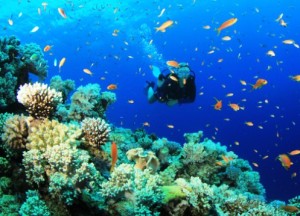Costa Rica’s Snorkeling and Scuba Diving Hotspots
Framed by more than 800 miles of picturesque coastline, Costa Rica features ample opportunities for underwater explorations. Swim among graceful sea turtles, vibrant parrotfish and spotted eagle rays as you investigate the country’s living coral reefs, mysterious caves and fascinating shipwrecks. While visibility varies depending on location and your time of visit, you can always count on warm waters and extraordinary encounters with inquisitive marine creatures. (Costa Rica is home to more than 7,000 species!)
Click here and book your luxury villa today!

Best destinations for snorkeling and scuba diving
Here’s a quick breakdown by region of the country’s top locales for diving and snorkeling. Most beach towns, including Tamarindo, Manuel Antonio and Puerto Viejo rent snorkels, masks and fins by the hour or half-day.
- Southern Caribbean: Manzanilla, Punta Uva, Puerto Viejo and Cahuita – wonderful snorkeling on Cahuita’s 600-acre coral reef.
- Tortuga Island – an easy day trip from Santa Teresa or Montezuma, Turtle Island is renowned for its sparkling clear waters, underwater rock formations and fantastic snorkeling.
- Southern Pacific: Cano Island’s volcanic seascapes create a rich habitat for stingrays, sharks, sea turtles and hundreds of reef fish. Many say the diving here is the finest in the country – only bested by Cocos Island Marine Park.
- Northern Pacific: Just off Playa del Coco lie the Catalina and Bat Islands – both famous for their large numbers of sea turtles, white tip sharks and eagle rays. Rich marine life can also be found snorkeling in Ocotal Bay.
- Central Pacific: A handful of dive sites off Manuel Antonio and Jaco are a short 20-minute boat ride away. Las Gemelas is one in particular that’s ideal for beginner dives.

Fun dives and PADI certification in Costa Rica
Throughout the country, dive shops offer fun dives or discovery dives for beginners who have no prior training or experience. These one-day affairs include instruction, hands-on practice and a guided tour accompanied by a dive master. For those who want to earn their PADI (Professional Association of Dive Instructors) certification, look for operators that provide 4-day courses for open water dives – which allow explorations up to 60 feet deep. Typically included in the course are classroom study followed by several pool dives and supervised dives at a local open water site.
Diverse aquatic life on both Atlantic and Pacific coasts
So what types of creatures can you expect to see on a scuba or snorkeling tour in Costa Rica? The southern Caribbean’s coral reefs are undoubtedly the best spot for spotting tropical species such as king angelfish, parrotfish, needle fish, Moorish idle, eels, octopi, puffer fish, rays and plenty of algae-feeding corals. Along the northern Pacific coast, near Playa del Coco, silky and white tip reef sharks as well as cow-nose and spotted eagle rays are common. Whale sharks are more elusive but have been observed along the Osa Peninsula and Cano Island. Endangered marine turtles – loggerhead, green, leatherback, Olive Ridley and hawksbill – are a tourist favorite, and can be seen off of both coasts year-round, though their numbers increase during mating season.
